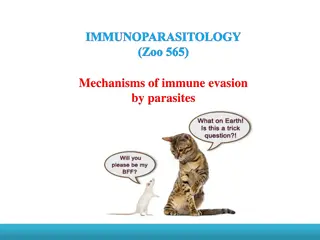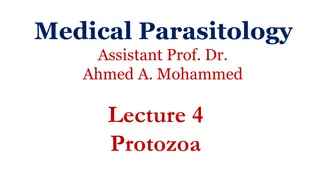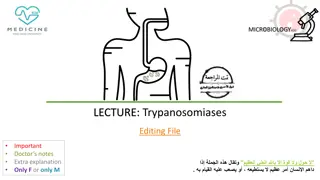Mechanisms of Immune Evasion by Parasites in Immunoparasitology
Understanding how parasites evade the immune system of their hosts is crucial in the field of immunoparasitology. Parasites have developed various strategies such as anatomical seclusion, antigenic variation, and intracellular living to avoid host immune responses. Examples include Plasmodium within
0 views • 26 slides
Life Cycle and Morphology of Blood and Tissue Flagellates in Parasitology
Blood and tissue flagellates, such as Leishmania and Trypanosoma, have complex life cycles involving vertebrate and arthropod hosts. They go through various stages with distinct morphological features like promastigote, epimastigote, trypomastigote, and amastigote. Leishmania mainly infects mammals
0 views • 16 slides
Understanding Trypanosomiases: African Sleeping Sickness and Chagas Disease
Trypanosomiases are parasitic diseases caused by Trypanosoma parasites, with African sleeping sickness and Chagas disease being the two main types affecting humans. African sleeping sickness, transmitted by the tsetse fly, can lead to chronic or acute illness and is primarily found in Africa. The di
0 views • 13 slides
Overview of Trypanosomes: Characteristics, Life Cycle, and Diseases
Trypanosomes are hemoflagellates that reside in the blood and tissues of vertebrate hosts and insect vectors. They undergo a complex life cycle involving two hosts and different developmental stages. Trypanosomes cause diseases like African Trypanosomiasis (sleeping sickness) and South American Tryp
0 views • 43 slides
Understanding Hemoflagellates: Leishmania and Trypanosoma Species
Hemoflagellates are blood and tissue parasites belonging to the genera Leishmania spp. and Trypanosoma spp. This article discusses their life cycle, pathogenicity, diseases they cause like visceral and cutaneous leishmaniasis, and diagnostic methods. Special focus is given to Leishmania donovani and
0 views • 14 slides
Medically Important Hemoflagellates: Trypanosoma and Leishmania
Hemoflagellates belong to the phylum Sarcomastigophora and include medically significant genera such as Trypanosoma and Leishmania. These parasites are transmitted by insects and exhibit complex life cycles. Trypanosoma species, such as T. cruzi and T. brucei, cause diseases like Chagas' disease and
0 views • 18 slides





